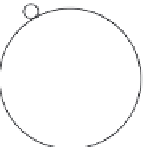Environmental Engineering Reference
In-Depth Information
l
f
=
L
f
I
f
I
a
X
T
=
kl
f
I
a
X
w
X
I
f
I
a
X
X
Figure 7.1 Dc motor torque production
working flux in the stator bore as shown by the vector l
f
. If field current is supplied
via the armature (field winding in series with the armature), the machine becomes a
series wound dc machine. In automotive applications, series wound brushed dc
machines were used nearly universally until they were replaced with permanent
magnet motors. A permanent magnet, brushed dc machine, is the direct analogue of
a shunt wound type for which a constant excitation is applied.
Torque control in the brushed dc machine is realized either by manipulation of
the field current or by controlling the armature current. Because field current
control is slow relative to armature control, brushed dc machines for automotive
applications, principally traction, generally use armature control. The torque in a
permanent magnet dc machine can be controlled as fast as the armature current can
be manipulated.
7.1 Essentials of field oriented control
FOC, or vector control, as is common terminology, is now a well accepted control
technique for all ac electric machines, enabling their performance and control
characteristics to resemble those of an armature controlled dc machine [1]. The
principles of FOC apply equally to synchronous and asynchronous machines, but in
this section the asynchronous machine is discussed because it is very common in
hybrid propulsion systems in North America and Europe. The interior permanent
magnet machine is also common in hybrid propulsion systems, primarily in Asia-
Pacific regions. Figure 7.2 illustrates in schematic form the essential structure of an
induction machine consisting of three stator phases represented as winding resis-
tances and self-inductances. A rotor consists of cast aluminium 'windings' that are
represented by inductances having their terminations shorted together by end rings
on the rotor. There are also mutual inductances that represent the coupling between
stator phases and rotor phases and amongst themselves.
The equations representing the cage rotor induction machine are stated below
for both the stator and rotor in the
d-q
reference frame illustrated in Figure 7.2.


































